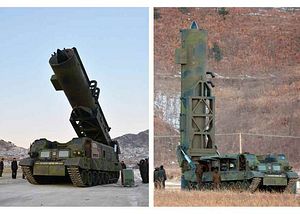Early on Sunday morning, North Korea launched an unidentified ballistic missile, according to South Korea’s Joint Chiefs of Staff. The launch took place near Kusong, in the country’s west, and flew for around 700 kilometers before splashing down in the Sea of Japan, according to the South Korean military and the Japanese government.
According to a U.S. Pacific Command spokesperson, the flight trajectory “was not consistent with an intercontinental ballistic missile.” The statement also noted that the United States was still assessing the type of missile tested.
Japan’s chief cabinet secretary, Yoshihide Suga, noted that the missile flew for about 30 minutes before splashing down in the Sea of Japan. Japanese Defense Minister Tomomi Inada stated that the missile apogee was greater than 2,000 kilometers, strongly suggesting that whatever North Korea tested on Sunday was likely a new type of intermediate-range ballistic missile with a range greatering than the Hwasong-10 (Musudan).
In 2016, North Korea tested six Musudan missiles and two missiles that were “presumed” to be Musudans, according to U.S. Strategic Command. Only one of the six tests succeeded, exhibiting a range of 400 kilometers and an apogee of 1,400 kilometers.
David Wright, codirector of the Union of Concerned Scientists Global Security Program, observes that given the flight time and range estimates, this new missile may exhibit a range of up to 4,500 kilometers, putting the U.S. territory of Guam well within range. The range of the Musudan system would put it just short of striking the U.S. territory.
The last launch to take place out of Kusong was the February 12, 2017, successful launch of the Pukkuksong-2 solid-fuel medium-range ballistic missile, the first launch of that specific system.
Sunday’s launch is the first since North Korea carried out a failed test on April 29 out of the Pukchang Airfield in South Pyongan province. That test failed shortly after launch, according to a statement by U.S. Pacific Command.
Sunday’s launch is also the first since South Korean voters elected liberal Moon Jae-in to the presidency last week. In his inaugural address, Moon suggested that he would look to go to North Korea under the right conditions. He is widely seen as favoring engagement with Pyongyang over confrontation.
The launch also came hours before Chinese President Xi Jinping opened China’s first-ever Belt and Road Forum — a major diplomatic event involving at least two dozens heads of state.
South Korean President Moon Jae-in convened an emergency meeting of the National Security Council to assess the launch. A Japanese government spokesperson, meanwhile, said that Japan “strongly protests” North Korea’s latest ballistic missile launch.
Sunday’s test is the 10th ballistic missile launch by North Korea in 2017. Aside from Sunday’s launch, Pyongyang has tested one Pukkuksong-2 medium-range ballistic missile, four extended-range (ER) Scud missiles, two missiles that are thought to have been the KN-17, a Scud variant with a potentially maneuverable reentry vehicle, and two other unknown missiles that failed.
Given that Sunday’s test appears to have been a success, North Korea will likely release official images and footage of the launch in Monday’s edition of the Rodong Sinmun, a state-run newspaper.
































